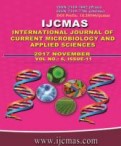


 National Academy of Agricultural Sciences (NAAS)
National Academy of Agricultural Sciences (NAAS)

|
PRINT ISSN : 2319-7692
Online ISSN : 2319-7706 Issues : 12 per year Publisher : Excellent Publishers Email : editorijcmas@gmail.com / submit@ijcmas.com Editor-in-chief: Dr.M.Prakash Index Copernicus ICV 2018: 95.39 NAAS RATING 2020: 5.38 |
Urinary tract infection (UTI) is one of the most frequent health problems in clinical settings. E. coli is the most prevalent organism causing both community as well as hospital acquired UTI. Uropathogenic E. coli shows increasing rates of resistance to various antibiotics. The frequent and improper usage of antibiotics resulted in the development of resistant strains of bacteria. To determine antimicrobial susceptibility pattern of uropathogenic E. coli isolates and evaluate the production of ESBL (Extended Spectrum β-Lactamases) and AmpC by the multidrug resistant strains. Uropathogenic E. coli strains, over the period of the study, were collected and studied. Antibiotic susceptibility testing was done. Phenotypic detection of ESBL production was done among the multidrug resistant (MDR) strains using the Modified Double Disc Synergy Test (MDDST). All the isolates which showed a synergistic effect with cefepime were further assessed for the production of AmpC enzyme by AmpC disc test. Two hundred non duplicate E. coli strains were recovered during the period of the study. Out of them 139 (69.5%) strains were MDR, of which 129 (64.5%) isolates were found to be ESBL producers (P < 0.001). Pure ESBL production was seen in 98 (49%) isolates, while31 (15.5%) isolates were co-producers of ESBL and AmpC. MDR uropathogenic E. coli becomes prevalent in clinical setting. This is attributed to both ESBLs and AmpC production. It is essential to limit antibiotic consumption and to establish protocol for routine and regular monitoring of ESBL production among clinical isolates.
 |
 |
 |
 |
 |